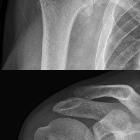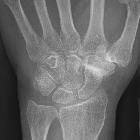Arthrose
























Osteoarthritis (OA) is the most common form of arthritis, being widely prevalent with high morbidity and social cost.
Terminology
Some authors prefer the term osteoarthrosis instead of osteoarthritis as some authors do not believe in an inflammatory cause as might be suggested by the suffix "itis". The condition is sometimes called non-erosive osteoarthritis, to differentiate it from erosive osteoarthritis, although this is considered a form of osteoarthritis .
Epidemiology
Osteoarthritis is common, affecting ~25% of adults . The prevalence increases with age. In the age group below 50 years, men are more often affected, while in the older population the disease is more common in women. It is estimated that over 300 million people in the world suffered from OA in 2017 .
Clinical presentation
Patients present with decreased function from joint pain, instability, and stiffness . The pain is typically worsened by activity and decreases at rest; in later disease stages, it may become continuous . Many cases of radiological OA are asymptomatic and conversely clinically apparent OA may not manifest radiographic change .
Pathology
The pathogenesis and pathophysiology of OA are yet to be fully understood . Despite emphasis being placed on articular cartilage degeneration, the remainder of the joint is involved including bone remodeling, osteophyte formation, ligamentous laxity, periarticular muscle weakness, and synovitis .
Classification
Osteoarthritis can be :
- primary (idiopathic)
- absence of an antecedent insult
- strong genetic component with the disease primarily affecting middle-aged women
- secondary
- abnormal mechanical forces (e.g. occupational stress, obesity)
- previous joint injury
- post-traumatic osteoarthritis
- accounts for ~12% of all OA
- major cause in young adults
- prior surgery
- crystal deposition (e.g. gout, CPPD)
- inflammatory arthritis (e.g. rheumatoid arthritis, seronegative spondyloarthritis)
- hemochromatosis
- post-traumatic osteoarthritis
Distribution
OA can affect both the axial and appendicular skeleton. The most common peripheral joints affected include :
Risk factors
Strong risk factors for developing OA include :
- obesity
- increasing age
- female sex (particularly between the age 50 and 80)
- family history
Radiographic features
Key radiographic features are joint space narrowing (JSN), sclerosis, and osteophytosis. If all three of these findings are not present, another diagnosis should be considered. Recently, with increasing use of MRI in the assessment of OA, other findings have been studied, such as bone marrow lesions and synovitis.
- joint space narrowing
- characteristically asymmetric
- least specific: present in many other pathological processes
- sclerosis
- sclerotic changes occur at joint margins
- frequently seen unless severe osteoporosis is present
- osteophytosis
- i.e. development of osteophytes
- common degenerative joint disease finding
- will also be diminished in the setting of osteoporosis
- some osteophytes carry eponymous names, e.g. Heberden nodes, Bouchard nodes
- joint erosions
- several joints may exhibit degenerative erosions :
- subchondral cysts
- also known as geodes
- cystic formations that occur around joints in a variety of disorders, including, rheumatoid arthritis, calcium pyrophosphate dihydrate crystal deposition disease (CPPD), and avascular necrosis
- bone marrow lesions (BML)
- visible on MRI as bone marrow edema-like lesions, often adjacent to areas of cartilage damage - likely representing early OA changes
- have been shown to correlate with joint pain and progression of cartilage loss
- may progress to subchondral cysts
- synovitis
- a non-specific finding, present also in other diseases, including inflammatory and infectious conditions
- present in up to 50% of the patients with OA
- according to some authors it may be correlated with pain, disease severity and progression
Plain radiograph
Plain radiograph is the most commonly used modality in assessment of OA due to its availability and low cost. It can detect bony features of OA, such as joint space loss, subchondral cysts and sclerosis, and osteophytes. It is, however, relatively insensitive to early disease changes. Other limitations are a lack of assessment of soft-tissue structures and low intrareader reliability .
Scoring systems used to assess the severity of OA on radiographs include :
- Kellgren and Lawrence classification
- Osteoarthritis Research Society International (OARSI) atlas
CT
CT has excellent accuracy in assessing bony OA changes. It is especially useful in the assessment of the facet joints. In order to reliably assess the articular cartilage, an arthro-CT must be performed.
Ultrasound
Ultrasound is not routinely used in OA. The assessment of the bony structure and deep joint structures using this modality is impossible. However, it is useful in detecting joint effusion, synovitis, and osteophytes. It can also act as guidance in joint interventions.
MRI
MRI can very accurately assess both bones and soft-tissue joint structures. It can detect bone marrow changes and cartilage loss, both of which are early OA changes and are not visible on radiographs. On conventional MR, articular cartilage is best assessed using fluid-sensitive sequences with fat suppression; with the advent of new methods of cartilage quantification and composition assessment - currently used in research - the sensitivity is further increased. Contrast administration enhances the visualization of synovitis.
Several scoring systems using MRI assessment of OA of the knee have been proposed :
- Whole-Organ Magnetic Resonance Imaging Score
- Knee Osteoarthritis Scoring System
- Boston Leeds Osteoarthritis Knee Score
Nuclear medicine
While not routinely used in clinical practice, nuclear medicine studies can provide information about multiple joints in one examination. The changes in the joints with OA show increased radiotracer uptake due to reactive bone turnover. The potential disadvantage of a poor anatomical resolution can be solved by using hybrid imaging .
Nuclear medicine examination used in the assessment of OA are:
- scintigraphy with Tc-hydroxymethane diphosphonate (HDP)
- PET with FDG or F
Treatment and prognosis
There is no effective treatment to slow or reverse the changes of osteoarthritis . The mainstays of treatment include exercise, walking aids, bracing, and analgesia (including intra-articular steroid injections) . Arthroplasty can result in improved function and reduced pain .
History and etymology
The term "osteoarthritis" was introduced as a synonym for rheumatoid arthritis by John K. Spender in 1886, however, it was not until 1907 that Archibald E. Garrod applied the term to the condition that is now considered to be osteoarthritis .
Siehe auch:
- Heberden-Arthrose
- subchondrale Zysten
- Bouchard-Arthrose
- erosive Arthrose
- Arthrose Kiefergelenk
- Koxarthrose Gradeinteilung
- Rheuma Differentialdiagnose
- subchondrale Sklerosierung
- Gelenkspaltverschmälerung
- myxoid cyst
und weiter:
- Femoro-acetabuläres Impingement
- Tarsale Koalition
- Sakroiliitis
- Hüftkopfnekrose
- diabetisches Fußsyndrom
- Chondrokalzinose
- idiopathische kindliche Hüftkopfnekrose
- Dysplasia epiphysealis hemimelica
- osteoarthritis (mnemonic)
- epiphysäre Knochentumoren
- femoropatellare Dysplasie
- acetabular labral tears
- radiologisches muskuloskelettales Curriculum
- osseous lesions preferentially involving the epiphysis
- chondrocalcinosis (mnemonic)
- Kalziumpyrophosphat-Ablagerungskrankheit
- freier Gelenkkörper
- femoroacetabulares Impingement vom Cam-Typ
- degenerative subchondrale Knochenzyste
- differential diagnosis for metatarsal region pain
- dens erosion
- subchondral cysts (mnemonic)
- anterior hip pain
- Tibiaplateaufraktur
- Sklerosierung der Klavikula
- Spondylose
- temporomandibular joint pathology
- Aseptische Nekrose des Metakarpale-Köpfchens
- femoroazetabuläres Impingement (Pincertyp)
- patellofemoral pain syndrome
- haemochromatosis - skeletal manifestations
- Knorpelbildgebung
- muskuloskelettale Manifestationen Hämochromatose
- Goldimplantation

 Assoziationen und Differentialdiagnosen zu Arthrose:
Assoziationen und Differentialdiagnosen zu Arthrose:


